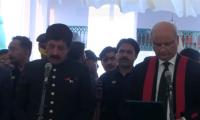ISLAMABAD: As if Monday’s polio vaccine-related fiasco in Peshawar was not damaging enough, the National Emergency Operations Centre (NEOC) for Polio Eradication Tuesday notified another two new polio cases—this time from Bannu and North Waziristan—taking the total number of polio cases in Pakistan to eight so far this year.
According to the NEOC, the infected children include a 22 month-old boy from district Bannu and a 2 year-old girl from tehsil Miranshah, tribal District North Waziristan of Khyber Pakhtunkhwa. So far in 2019, eight polio cases have been reported including two from Bannu, and one each from Karachi, Hangu, Waziristan, Lahore, Bajaur, and Khyber Tribal district. The press release further points out that it is everyone’s responsibility to ensure that two drops of the safe and effective polio vaccine are administered to all children during the currently ongoing nationwide door-to-door polio vaccination campaign.
Pakistan and Afghanistan are the last two countries in the world that are still struggling to eradicate poliovirus transmission despite decades of untiring efforts and colossal funding.
Pakistan has made great strides since the huge outbreak of 2014, when 306 polio cases were reported in the country. The establishment of EOCs in early 2015 led to improved coordination among partners as well as law enforcement agencies. Scientific data-based management at the EOCs and government ownership were other supportive factors.
The country reached case count of 8 in 2017 and 12 in 2018, which was a year of political transition that saw unprecedented transfer of officials at key positions from Chief Secretaries, Health Secretaries, Commissioners, DCs, DHOs, DPOs as well as district heads of other key government departments, affecting team dynamics significantly (e.g., Lahore saw 4 DCs and 5 CEOs of Health in one year).
This affected team dynamics, leading to gaps in oversight, and enabling the virus to bounce back. A continuing challenge—and a major one indeed for the polio programme—has been to keep communities on its side. Pakistan has particularly had serious challenges from an organized negative propaganda on social media leading to growing community resistance.
An added factor was the rising militancy across our borders where almost 1 million under-5 children were not reached by the Afghan programme with vaccine consistently in our shared corridors (Nangerhar, Kunar in North and Kandhar, Hilmand in south). The virus, therefore, kept pouring in, adding further pressure on the programme.
In Pakistan’s case, it is pertinent to consider that the country has dense population slums growing at a tremendous pace (almost 20,000 kids born every day).
Besides supplemental immunization done through door-to-door campaigns, reaching children with basic routineimmunization is exceedingly important to not leave immunity gap for the virus to survive. The second big factor peculiar to Pakistan and Afghanistan is huge population movement within countries as well as across the borders. However, contrary to the situation till 2015, all Pakistani children are accessible now due to unprecedented support from civil and military security agencies. The country just needs to gain the momentum back.
Currently, the biggest programme priorities are to consistently reach all children that are being missed either because of parental misconception or gaps in programme operations; to effectively covering high-risk mobile children wherever they are; to improve routine immunization coverage to sustain the polio gains and prevent morbidity and mortality associated with other vaccine-preventable diseases; to synchronizing strategies, approaches and activities with Afghanistan including vaccination of all people at the border crossings to compensate for inaccessibility within Afghanistan; and to urgently shut down virus transmission in core reservoirs by implementing a package including improved basic health services, essential immunization, water and sanitation services, as well as interventions for malnutrition.
“Vaccinating all children in every campaign is important to attain full immunity against poliovirus,” said Prime Minister Focal Person on Polio Babar Bin Atta, who believes in out-of-the-box solutions to control virus transmission. Fortunately, children who are vaccinated against polio multiple times are able to fight the virus back.
The more doses of the polio vaccine a child receives, the higher the chances of escaping lifelong paralysis. Children who are not vaccinated against polio or have not received enough doses of the vaccine to fight off the virus are at a far greater risk of developing lifelong paralysis or even dying.
“It is entirely safe to give multiple doses of the vaccine, in fact that is how the vaccine is designed. More doses will offer better protection against poliovirus, and that is why it is important that all children regardless of vaccination status are reached every time, during each vaccination round,” Babar added.
The government has returned the services of BS-20 officer of Information Service Shafqat Abbas to the Ministry of...
Previously, the prime minister had given four days to the committee to fix responsibily for the import of wheat
The petitioner stated that the electoral body had no authority to interpret the constitution
CM was briefed that in first phase, 12 schools for special children would be completely revamped this year
Anti-Corruption Establishment filed appeals against 58 sentences handed down by the courts from January 1, 2018 to...
These statistics reflect that on an average, 700,000 youngsters add up to the total number of out-of-school children...







